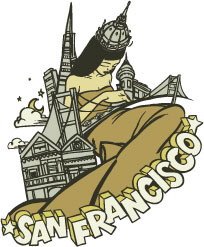 I had been curious about Gnosis for a minute- mostly because I kept encountering references to it in my reading. I knew fuck all about it, except that it comes from the Greek word for knowledge. So when I was browsing through the book store down the street and came across this for a mere $5.00, it seemed the universe was telling me something. After taking the cue I dove into a comprehensive and thoroughly satisfying book.
I had been curious about Gnosis for a minute- mostly because I kept encountering references to it in my reading. I knew fuck all about it, except that it comes from the Greek word for knowledge. So when I was browsing through the book store down the street and came across this for a mere $5.00, it seemed the universe was telling me something. After taking the cue I dove into a comprehensive and thoroughly satisfying book. First we are given a brief explanation of the function of religion, which is two fold:
- to bring man in contact with the absolute
- and possibly even more importantly, to act as an adhesive holding society together
With this established, he contrasts the mystic’s direct experience of the divine with second hand institutionalised orthodoxy . Those with direct spiritual access possess an inner resource and are generally autonomous. (Naturally they are seen by the church as a threat, and in times where the church wielded significant secular power were persecuted as such.) He sights an interesting recurring pattern in which a charismatic spiritual master will appear and through his teachings accrue disciples. After the master passes, the disciples will carry on the teachings. As time passes, the teachings become canonized and an institution is constructed to convey them second hand. This, Smoley says is how religions are formed.
Obviously, the most famous example of this in the Western world is Jesus of Nazareth. So it is there that we set out from. After a brief mention of the Gospels of Thomas, Smoley introduces us to the most prominent of the early Gnostic masters. Simon Magus, considered by the church to be the father of all heresy, heads the lot followed by Marcion, Valentinus and Basilides. From here, the roots of esoteric tradition are traced back to Plato and beyond to ancient India and Egypt. Consistently and often brutally persecuted by the emerging Papacy, Gnosticm was forced underground by 400 AD. There is no direct lineage after this, although the traditions and practices have been incorporated into countless sects, throughout the centuries. Consequently, the book jumps around quite a bit.
After the disappearance of the original masters, Christianity would, by a peculiar twist of fate, become “inoculated” with Gnosticism. This was due mainly to the teachings of influential theologins Clement and Origen who both rejected Gnosticism yet ironically embraced Gnosis. Manichaeism, is briefly discussed, for Mani’s belief that the physical world was a depraved illusion is a recurrent theme in the Gnostic tradition. And his dualistic doctrine of light and dark would influence orthodox Christianity immensely. The rise and fall of the Cathars, known as the Great Heresy is retold in the context of it’s gruesome fate at the hands of inquisitors. The Celtic tradition and Dionysus are also mentioned. The dark ages failed to engulf Ireland, resulting in a strain of Christianity that was cross-pollinated with more classical ideas and exotic practices.
The smashing of the Papacy’s iron grip over Western Civilization led to the the Renaissance, to a rediscovering of the Greek Classics, and a new flowering of esotericism. With it came Marcilio Ficino’s translation of the Corpus Hermeticus. Ficino’s pupil Giovanni Pico della Mirandola along with the German scholar Johannes Reuchlin translated the Jewish Kabbalah essentially introducing it's mystic practices to Western Europe. This period also witnessed the rise of prominent magi- most notably John Dee and Giordano Bruno who’s belief in ancient Egyptian Hermeticism would eventually cost him his life.
One of the most facinating parts of the entire book is the chapter on the secret society of Rosicrucianism and it’s catalyzing of Free Masonry. This hazy sequence of events has obviously been a point of intense interest. Having provided fodder for conspiracy theorists for nearly 300 years, the notorious Bavarian Illuminati's enduring legacy is a testament to their mystique if not their actual influence.
The last portion is dedicated to the reviving of Gnosticism in mainstream Western society. The timely publishing of books like Isis Unveiled by Helena Petrovna Blavatsky provided a spark for this movement, but it was the discovery of the Nag Hammadi Texts and The Gospels of Thomas that would blow it wide open and profoundely affect contemporary literature. Blake, Philip k Dick, the Da Vinci Code and Helen Schuman Course in Miracles all owe a dept to Gnostic tradition. In the final chapter entitled The Future of Gnosticism, we finally get some editorializing from Smoley. It's a beautifully written passage; a perfect way to round out the robust recounting of such a richly steeped history.
I would recommend this as a primer to anyone interested in esoteric Western religion. Or for those who are already familiar but interested in it’s influence over the course of Western civilization. At just over 200 pages this relatively brief volume packs quite a bit of information.













No comments:
Post a Comment